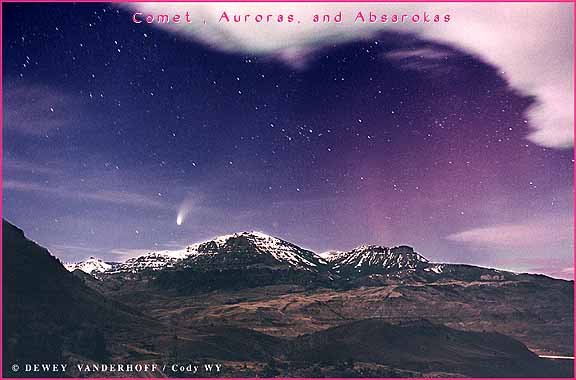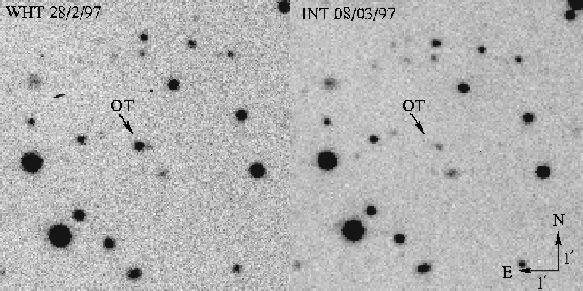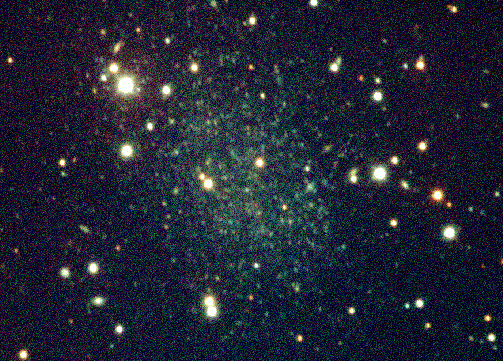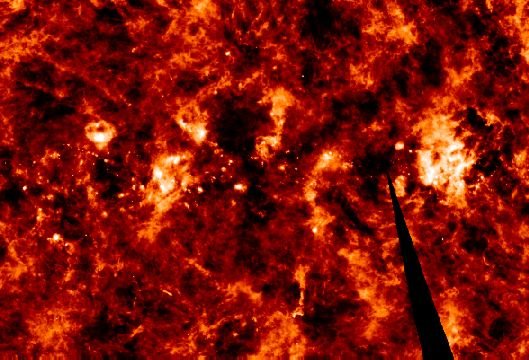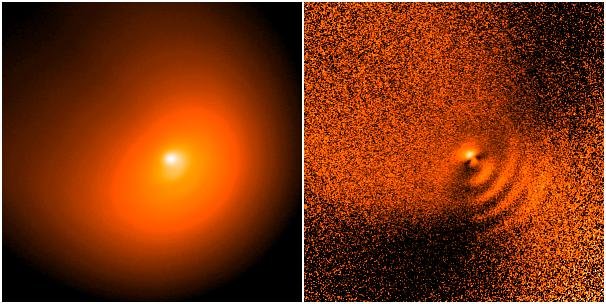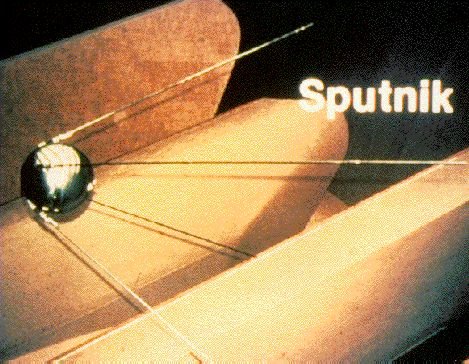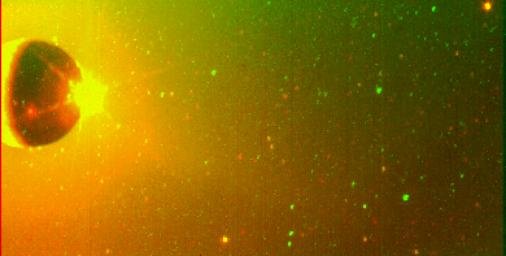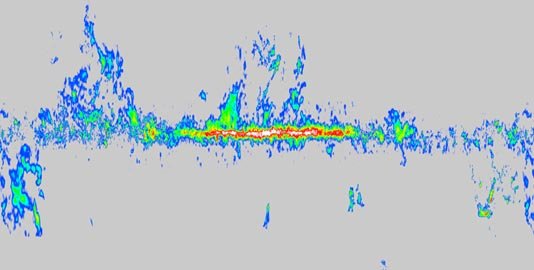NASA APOD #672-681
#672 Big Sky Comet
Credit and Copyright: April 21, 1997
“On April 17th, "Big Sky" country sure lived up to its name. The dark skies over the US states of Wyoming, Montana and the Dakotas were quite busy, as shown by this photograph featuring Comet Hale-Bopp. In the foreground is the Absaroka Mountain Range in Wyoming, lit by reflected moonlight. Just to the left of Jim Mountain's peak is Comet Hale-Bopp. The unusual colors visible on the far right are aurora, remnants of the recent solar storm recorded on the Sun. Across the middle of the photo are numerous bright stars, and across the top of the picture are clouds. "
Copyright: Public domain
#673 Historic Optical Flash Fades
Credit and Copyright: April 22, 1997
“The largest telescopes in the world have scrambled to point toward this faint, fading object. Why? Because it may well be the first active optical counterpart ever found for a gamma-ray burst, and could hold the clue to the distance scale to this most enigmatic class of astronomical objects. During the past two months, multiwavelength observations, claims, and counterclaims have been exchanged at a torrential pace, as astronomers wait impatiently to see what setting houses the fading transient. Above are two pictures of the optical transient (OT), one taken on February 28th, the other about a week later on March 8th. The OT arrows show the source that faded from view during this time. The OT has been examined by large telescopes including the Hubble Space Telescope and Keck, yet researchers are still scrambling to get answers to fundamental questions about its true nature. Does the OT actually move (exhibit proper motion)? Is there a faint galaxy superposed behind the OT or is this extended emission fading too? In the face of intense scrutiny with the world's most capable telescopes, the origin of gamma-ray bursts so far remains mysterious!"
Copyright: Public domain
#674 Antlia: A New Galactic Neighbor
Credit and Copyright: April 23, 1997
“Meet Antlia, a newly discovered neighbor of our Milky Way Galaxy. Announced just last week, this faint member of our Local Group of Galaxies has only about one million stars. It is late in being noticed because it is so hard to see against a bright sky. This faint galaxy is seen here in the background - the bright stars visible are in our own galaxy. The Antlia Dwarf Galaxy is actually a dwarf spheroidal galaxy, similar to nine known dwarf spheroidals that orbit our Milky Way Galaxy. Antlia, named for the constellation in which it resides, is unusual because it does not hover near either of the two major galaxies of the Local Group: our Milky Way Galaxy and M31. "
Copyright: Public domain
#675 The Frothy Milky Way
Credit: April 24, 1997
“Astronomers have recently discovered that looking at dust along the plane of our Milky Way Galaxy is a bit like looking into a frothy glass of beer. The dust between stars in our galaxy is arranged like a foam with bubbles and voids -- apparently churned by shocks and winds generated as stars cycle through their lives. This processed infrared image, based on data from NASA's IRAS satellite, maps the radiation from the edges of galactic dust clouds and reveals the complex distribution. The image covers an area of about 40x60 degrees centered on the galactic plane near the Cygnus region. It shows bright bubble-shaped and arc-like dust clouds around the supernova remnants and starbirth regions embedded in the galactic disk."
Copyright: Public domain
#676 Hale-Bopp Polarized
Credit and Copyright: April 25, 1997
“Light polarization is familiar to many outdoor enthusiasts who use polarizing sunglasses to cut the glare of reflected light. These two views of comet Hale-Bopp also demonstrate the effect of polarization. At left is an "ordinary intensity image" of Hale-Bopp's coma taken April 14, while on the right a similar image made with polarizing filters represents the intensity of polarized light. The arcs visible in the polarized view probably correspond to concentrations of ejected cometary dust that produce polarization by reflecting sunlight. Any sort of reflection - from clumps of comet dust or the surface of your favorite lake or ski slope - can polarize light by causing the light waves to vibrate in a plane defined by the reflecting surface."
Copyright: Public domain
#677 The Perseus Cluster of Galaxies
Credit: April 26, 1997
“Here is one of the largest objects that anyone will ever see on the sky. Each of the fuzzy blobs in the above picture is a galaxy, together making up the Perseus Cluster, one of the closest clusters of galaxies. We view the cluster through the foreground of faint stars in our own Milky Way Galaxy. It takes light roughly 300 million years to get here from there, so we only see this cluster as it existed during the age of the dinosaurs. Also known as Abell 426, the center of Perseus cluster is a prodigious source of X-ray radiation, and so helps astronomers study how clusters formed and how gas and dark matter interact. The Perseus Cluster of Galaxies is part of the Pisces-Perseus supercluster of galaxies, which spans over 15 degrees and contains over 1000 galaxies. "
Copyright: STScIAAO
#678 Sputnik: Traveling Companion
Courtesy: April 27, 1997
“Sputnik means "traveling companion". Despite the innocuous sounding name, the launch of the Earth's first "artificial moon", Sputnik 1, by the Soviets on October 4, 1957 shocked the free world, setting in motion events which resulted in the creation of NASA and the race to the Moon. Sputnik 1 was a 184 pound, 22 inch diameter sphere with four whip antennas connected to battery powered transmitters. The transmitters broadcast a continuous "beeping" signal to an astounded earthbound audience for 23 days. A short month later, on November 3, the Soviets followed this success by launching a dog into orbit aboard Sputnik 2."
Copyright: Public domain
#679 Io's Sodium Cloud
Credit: April 28, 1997
“Io has its own cloud. Jupiter's most active moon is visible on the left of the above false-color photograph, with its left side illuminated by sunlight. But what is happening on Io's right side? Here a plume of gas from the active volcano Prometheus also reflects sunlight. A second active volcano, Pele, is also visible: marked by the red spot just below Io's center. Surrounding the moon is a yellow haze originating from gas ejected by Io's volcanos. Sodium atoms in the gas cloud are particulary efficient at reflecting yellow light. Several points of light are background stars."
Copyright: Public domain
#680 Hale Bopp and Orion
Credit and Copyright: April 29, 1997
“Comet Hale-Bopp is still brighter than most constellations. In fact, Comet Hale-Bopp may now hold the record for staying bright the longest. Last week the comet was photographed above in the same field as the constellation Orion, visible in the photograph's center, as well as with Sirius, the brightest star in the night, visible on the far left. Just below Comet Hale-Bopp on the right is the volcanic caldera known as White Mountain.. As the comet heads south, it has become visible to most of the world, now including many observers in the Earth's Southern Hemisphere."
Copyright: Public domain
#681 Milky Way Molecule Map
Credit: April 30, 1997
“Where are the Milky Way's gas clouds and where are they going? Stars form in gas clouds, and the motion of gas clouds tell us about the size and rotation speed of our own Milky Way Galaxy. But gas clouds are hard to detect - they are composed mostly of nearly invisible molecular hydrogen and helium. Fortunately, at least small amounts of heavier gases co-exist, one of them being carbon monoxide (CO), which is relatively easy to detect at radio wavelengths. Therefore, over the past decade, a team of astronomers have carefully mapped out the molecular sky to unprecedented clarity - to about four times previous resolution and about eight times previous sensitivity. The resulting map is shown above, rescaled and in false color, with dark blue being relatively low emission. The band of our Milky Way Galaxy spans the middle. The data have not only helped our understanding of the Galaxy, but highlight a few mysteries too. For example: what causes the rapid speed of the gas near the Galactic Center?"
Copyright: Public domain
Upvote! Resteem! Comment! As you like it! Thank you for attention!
